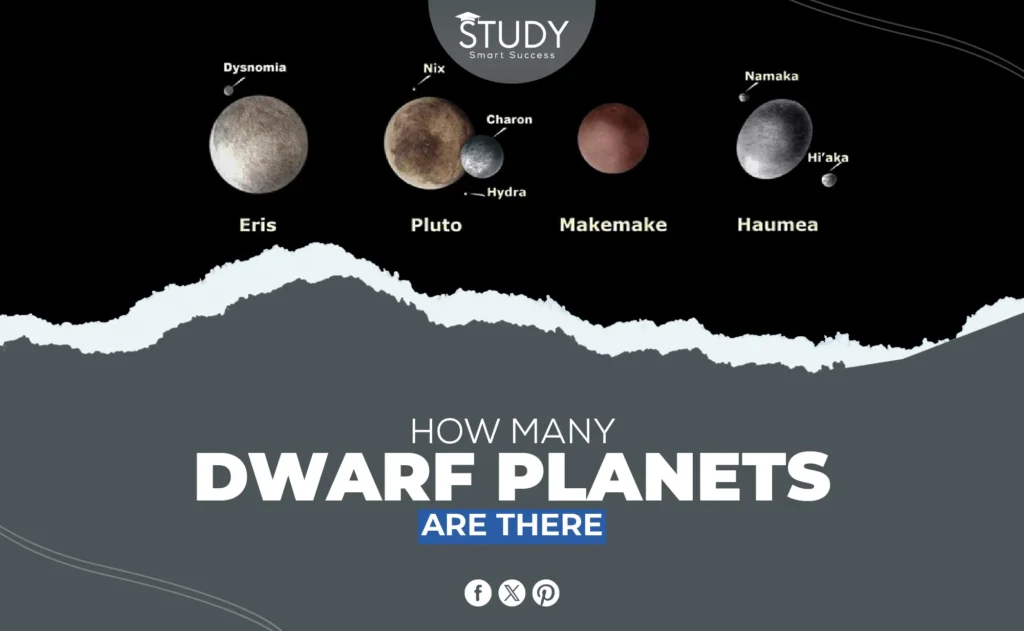Introduction
Astronomers have created the term “dwarf planet” to identify things in our solar system that don’t meet the classic planet classification. Dwarf planets are celestial entities that resemble planets but differ in crucial ways. Now, how many dwarf planets are there in our solar system?
The International Astronomical Union (IAU), which names and classifies astronomical objects, defines dwarf planets as:
- It goes around the Sun.
- It has enough mass for its gravity to be stronger than stiff body forces, making it almost round.
- It is different from full-fledged planets because it has not cleared its circular path of other objects.
- It’s not the moon.
This set of rules arose because of a need to group things in the solar system. They were found to be like planets but different from them. To gain understanding, one must understand these unique bodies in terms of how our solar system works and how it has changed over time. Read more about exoplanets on our website.
History of Dwarf Planets
A fascinating part of astronomy is the study of small planets. This field is formed by new information and shifting categories. The journey to figure out how our solar system is put together has greatly changed. It changed when well-known heavenly bodies were put in different groups.
Before the word “dwarf planet” was invented, the solar system contained planets, moons, asteroids, and comets. As telescopes and technology improved, scientists discovered many more Kuiper Belt objects beyond Neptune, making these groups unclear. The discovery of these things made it clearer what a planet is.
Reclassification of Pluto
Pluto’s 2006 reclassification prompted discussion and public interest in minor planet history. The IAU downclassed Pluto, discovered in 1930, as a dwarf planet. Pluto fits the first two conditions of being in orbit around the Sun and being spherical due to its own gravity, but it does not empty its orbit of debris.
The IAU’s dwarf planet category improved our understanding of the solar system’s dynamics and composition. It acknowledged that our solar system is more diverse and complex than imagined, paving the way for future research.
The Known Dwarf Planets
Five celestial bodies are dwarf planets, according to the IAU. Each dwarf planet has unique properties and, in certain circumstances, moons that complicate our solar system. Let’s examine each:
Pluto
Discovery
Pluto was discovered by Clyde Tombaugh at Lowell Observatory in Arizona in 1930 as the eighth planet. 11-year-old Venetia Burney suggested naming it after the Roman underworld god.
Features
Pluto’s terrain includes mountains, valleys, plains, and craters. The nitrogen ice surface contains methane and carbon monoxide. The most notable feature is Tombaugh Regio, a nitrogen-rich heart-shaped glacier named after its discoverer.
Moons
Pluto has five moons: Charon, Styx, Nix, Kerberos, and Hydra. Some call them a twin dwarf planet system since Charon, the largest, is larger than Pluto. Charon is half the diameter of Pluto and has a mutual gravitational lock, so they always face each other.
Eris
Discovery
In 2005, a group led by Mike Brown used the Palomar Observatory in California to find Eris. It is one of the biggest small planets in our solar system, and it is in the area beyond Neptune called the “scattered disc.”
Features
Eris’s diameter is about 2,326 kilometers, a little less than Pluto’s. However, it has a higher mass, which makes it heavier. A layer of methane ice covers its surface, making it very reflective, and its path around the sun is about 96 times farther than Earth’s.
Moons
Dysnomia, Eris’s only known moon, was found not long after Eris itself. In 2006, after Eris and its moon were found, Pluto was reclassified as a dwarf planet by the International Astronomical Union. This showed that Pluto was not the only object in its part of the solar system.
Haumea
Discovery
A group at the Sierra Nevada Observatory found Haumea in 2004. It is a unique star because of its long shape, which comes from spinning very quickly. The name of this dwarf planet comes from the Hawaiian goddess of birth and wealth.
Features
Because it spins so quickly—in less than 4 hours—it is famous for that. Its strange, long shape—it looks more like a rugby ball than a normal spherical celestial body—is partly due to its fast spin.
Moons
Hi’iaka and Namaka are Haumea’s two moons. They are thought to have formed from pieces of other planets that collided with Haumea. The brighter and bigger star, Hi’iaka, was found in 2005 and is named after the Hawaiian goddess of dance. Soon after, Namaka, the smaller moon, was found. Its name comes from a Hawaiian mythological water spirit.
Makemake
Discovery
A group of scientists found it at the Palomar Observatory in 2005. It was named after the creator god of the Rapa Nui people on Easter Island, which shows how important it is to their culture and how it ties into old mythology.
Features
Makemake is one of the coldest places in the solar system because it doesn’t have an atmosphere. It gets as cold as -398°F (-239°C). Its surface is thought to be reddish-brown because it is covered in methane, ethane, and maybe even nitrogen ice.
Moons
In 2016, a small moon called MK 2 was found orbiting Makemake. Its diameter is about 175 kilometers (110 miles), and it orbits Makemake about 21,000 kilometers (13,000 miles) away. As a result of this finding, astronomers can now learn more about Makemake’s mass and makeup.
Ceres
Discovery
Italian astronomer Giuseppe Piazzi found Ceres in 1801. It is the first and biggest rock found in this area, and it is unique. It is found in the asteroid belt between Mars and Jupiter.
Features
Ceres is the sole dwarf in the inner solar system. It has water ice and may have had a subterranean ocean, which implies microbial life. Craters and brilliant patches on its surface may represent salt deposits.
Moons
Ceres doesn’t seem to have any moons for a body of its size. However, its gravitational pull affects other asteroids in the belt.
Each of these small planets tells us different things about how the solar system formed and changed over time. These bodies give us important information about the universe, from Ceres’s wet history to Pluto’s active geology.
Candidate Dwarf Planets
Officially, the International Astronomical Union (IAU) only accepts five dwarf planets. However, many other objects in space are good candidates for this category within the solar system. Authorities are keeping a close eye on these prospects. These objects are being studied to find traits that could make them more like dwarf planets.
Astronomers think that the following objects in space are the most likely candidates to become dwarf planets:
- Sedna: In 2003, Sedna was discovered with an extremely long and distant orbit that takes 11,400 years to orbit the Sun. This orbit challenges our concept of solar system boundaries. Sedna, one of the reddest objects in the solar system, has sparked speculation about a distant planet affecting its orbit.
- Orcus: Orcus, discovered in 2004, is similar in size to Pluto’s moon Charon and orbits the sun almost oppositely, earning the nickname “the anti-Pluto.” Orcus’ moon Vanth is huge for its size, suggesting an unusual gravitational relationship. The surface of Orcus may contain water and methane ice.
- Quaoar: In 2002, Quaoar was discovered in the Kuiper Belt and is half the size of Pluto. Its moon, Weywot, reveals a dramatic collisional past like other dwarf planets with moons. Quaoar may have had a liquid ocean beneath its frozen crust made of rock and ice.
- 2007 OR10 (Gonggong): Gonggong is one of the largest Kuiper Belt objects not yet classed as a dwarf planet. Its crimson color and sluggish spin suggest a complex surface and atmosphere. Gonggong may have a moon, which could help scientists determine its mass and density. Solar light may convert methane ice on its surface to red.
Criteria and Observations for Classification
The IAU has set certain requirements for these candidates in order to be considered for the label of “dwarf planet”:
- Orbit Around the Sun: The object must go around the Sun in a straight line, not as a satellite around another star. Because of its gravitational pull on the Sun, the object moves around the Sun in an elliptical path. This makes it different from moons that circle planets.
- Spherical Shape: The object needs enough gravity to form a nearly spherical shape. This means the body has enough mass for self-gravity to overcome rigid body forces, achieving hydrostatic equilibrium. The object has enough mass for gravity to create a stable, spherical shape.
- Has Not Cleared the Orbit: Unlike planets, the object does not need to clean its orbit of junk. Unlike planets, the object orbits together with other similar-sized bodies. It has not dominated its orbital region by gathering or pushing away smaller bodies, distinguishing it from a planet.
Telescope and space mission observations help astronomers determine if these bodies satisfy the criteria. Size, shape, orbital dynamics, and geological activity are important factors. As technology and data improve, the number of dwarf planets may grow, enriching our grasp of the solar system’s diversity and complexity.
Importance of Dwarf Planets in the Solar System
Dwarf planets are a unique and important part of the solar system, revealing its history and evolution. Their research improves our grasp of celestial physics and composition and helps us understand the solar system’s intricate history.
- Diverse Celestial Mechanics: Pluto and Eris enable astronomers to study gravitational and orbital dynamics that differ from larger planets. Their various orbits and interactions with other celestial bodies reveal solar system forces. This diversity enhances our understanding of celestial mechanics by showing the various interactions and forces at play.
- Composition and Atmosphere: Many dwarf planets have distinct atmospheres and surfaces (compared to larger worlds). Pluto’s surface is mostly nitrogen ice with traces of methane and carbon monoxide, which can reveal early solar system elements. Scientists can deduce the chemical processes of solar system formation from these compositions.
- Benchmark for Planetary Formation: Dwarf planets are relics of the primordial building blocks that formed larger planets. Scientists learn about planetary formation by analyzing dwarf planets like Ceres in the asteroid belt. Some of these findings include material accretion and how warmth and pressure shape planetary cores.
- Tracing the Solar System’s History: Small planets in the Kuiper Belt and beyond preserve early solar system conditions like time capsules. Their surface features and compositions allow scientists to rebuild the solar system’s early chemical and physical circumstances, revealing the planets’ formation environment.
When you study dwarf planets, it’s not enough to understand these small things. You must use their presence to figure out the bigger mysteries of the solar system. Every new finding in this area changes how we think about space. It leads to new ideas and more questions about where we fit in the universe.
Conclusion
Comprehending and investigating dwarf planets is vital for comprehending our local cosmic neighborhood and the cosmos as a whole. These little but important entities help explain our solar system’s intricate evolution.
Research on dwarf planets improves our understanding of planetary formation and migration. Each trip to these remote worlds advances technology with major Earth applications. Studying these bodies also promotes international cooperation in research and technology.
Dwarf planets fascinate and inspire STEM careers. NASA’s New Horizons mission to Pluto excites the public and promotes space exploration. We must support future expeditions and astronomical research to continue exploring the universe.
While we gaze at the stars, let us not neglect dwarf planets, whose mysteries reveal the fundamental fabric of our solar system. Fostering curiosity and supporting space missions and astronomy leads to discovery, inspiration, and unification under the flag of exploration.


